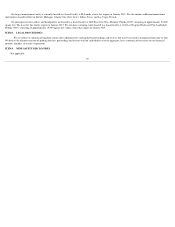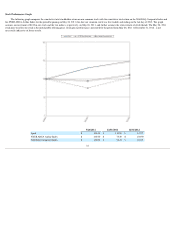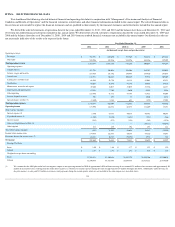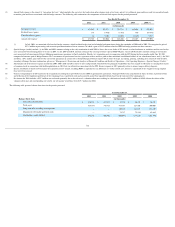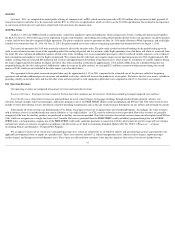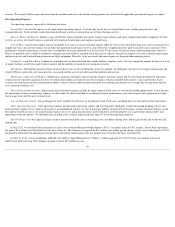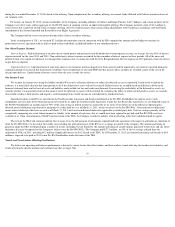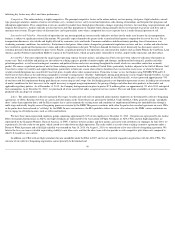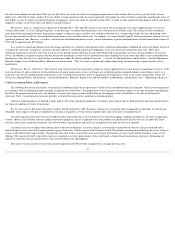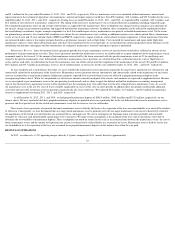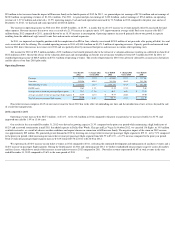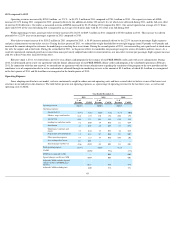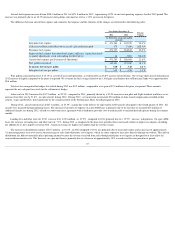Spirit Airlines 2012 Annual Report Download - page 38
Download and view the complete annual report
Please find page 38 of the 2012 Spirit Airlines annual report below. You can navigate through the pages in the report by either clicking on the pages listed below, or by using the keyword search tool below to find specific information within the annual report.
2011 IPO
On June 1, 2011, we completed our initial public offering of common stock, or IPO, which raised net proceeds of $150.0 million after repayment of debt, payment of
transaction expenses and other fees. In connection with the IPO, we effected a recapitalization, which we refer to as the 2011 Recapitalization, that resulted in the repayment
or conversion of all of our notes and shares of preferred stock into shares of common stock.
2010 Pilot Strike
On May 13, 2010, the NMB released us and the pilots’ union from mandatory supervised mediation, which commenced a 30-day “cooling off” period as provided in
the RLA. On June 12, 2010, following several negotiation sessions with the pilots’
union during the cooling off period that did not result in an agreement, our pilots declared
a strike, and we were forced to suspend all flight operations. The parties reached a tentative agreement on June 16, 2010 under a Return to Work Agreement, and a full flight
schedule was resumed on June 18, 2010. On July 23, 2010, the pilots ratified a five-year collective bargaining agreement that became effective on August 1, 2010.
The results of operations for 2010 were materially adversely affected by the pilot strike. The pilot strike resulted in reduced bookings in the period leading up to the
strike as our customers became aware of the impending end of the cooling off period, and lost revenues while flight operations were shut down and while we recovered from
the strike. We also experienced additional expenses related to the strike, including costs to reaccommodate passengers, offset by reduced variable expenses, such as reduced
fuel consumption and employee costs for flights not operated. We estimate that the strike had a net negative impact on our operating income for 2010 of approximately $24
million, resulting from an estimated $28 million in lost revenues and approximately $4 million of incremental costs, offset in part by a reduction of variable expenses during
the strike of approximately $8 million for flights not flown. The strike resulted in a reduction of approximately 145.8 million ASMs from our scheduled flying that was
suspended during the five-day strike period. Additionally, under the terms of the pilot contract, we also paid $2.3 million in return-to-work payments during the second
quarter of 2010, which are not included in the strike impact costs described above.
The agreement with our pilots increased our pilot labor costs by approximately 11% in 2011 compared to the estimated cost of the previous collective bargaining
agreement and includes additional pay rate increases and modified work rules, which will increase the productivity of our pilots. We believe the five-year term is valuable in
providing stability to our labor costs, and that the other terms will also provide us with competitive pilot labor costs compared to other U.S.-based low-cost carriers.
Our Operating Revenues
Our operating revenues are comprised of passenger revenues and non-ticket revenues.
Passenger Revenues . Passenger revenues consist of the base fares that customers pay for air travel, which fares include government-imposed taxes and fees.
Non-ticket Revenues. Non-ticket revenues are generated from air travel-related charges for baggage, bookings through our distribution channels, advance seat
selection, itinerary changes, hotel travel packages, and loyalty programs such as our FREE SPIRIT affinity credit card program and $9 Fare Club. Non-ticket revenues also
include revenues derived from services not directly related to providing transportation such as the sale of advertising to third parties on our website and on board our aircraft.
Substantially all of our revenues are denominated in U.S. dollars. Passenger revenues are recognized once the related flight departs. Accordingly, the value of tickets
sold in advance of travel is included under our current liabilities as “air traffic liability,” or ATL, until the related air travel is provided. Non-ticket revenues are generally
recognized at the time the ancillary products are purchased or ancillary services are provided. Non-ticket revenues also include revenues from our subscription-
based $9 Fare
Club, which we recognize on a straight-line basis over 12 months. Revenue is generated from the FREE SPIRIT credit card affinity program through the sale of FREE
SPIRIT miles, card acquisitions, ongoing use of the FREE SPIRIT credit cards, milestone payments in connection with the achievement of specific usage and user volumes,
and renewals, which we currently recognize in accordance with the criteria as set forth in Accounting Standards Update ASU No. 2009-13. Please see “—Critical
Accounting Policies and Estimates—Frequent Flier Program”.
We recognize revenues net of certain taxes and airport passenger fees, which are collected by us on behalf of airports and governmental agencies and remitted to the
applicable governmental entity or airport on a periodic basis. These taxes and fees include U.S. federal transportation taxes, federal security charges, airport passenger
facility charges, and foreign arrival and departure taxes. These items are collected from customers at the time they purchase their tickets, but are not included in our
37




